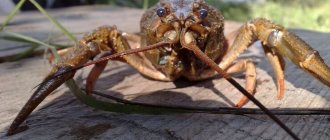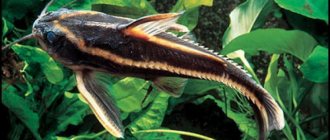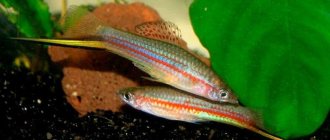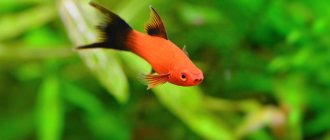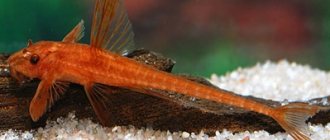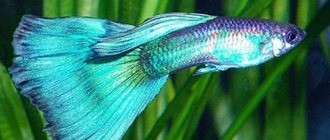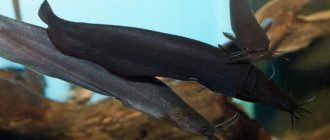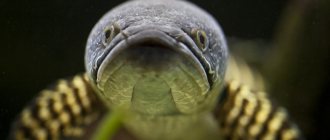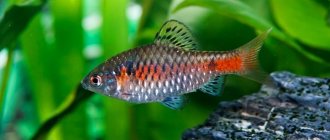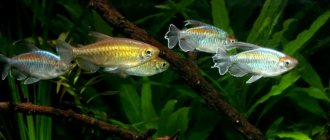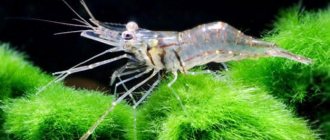Of course, everyone has heard about crayfish living in rivers around the world, in Russia and Germany and other countries. Moreover, everyone knows not only what an ordinary live crayfish looks like, but they have also eaten it. But not many people know that crayfish are different in all countries. This is due to the conditions of their existence and what they have to eat.
Our crayfish that live in the waters of the Don, Volga or Dnieper, even the largest ones, are considered relatively small, but the largest crayfish are the inhabitants of the rivers of Tasmania. It’s hard to imagine, but some of the largest individuals weigh more than 5 kilograms, and they grow up to 0.8 m in length! See what this breed of cancer looks like in the photo.
The world's largest Tasmanian crayfish
But, unfortunately, such individuals are now rare even in those parts. This happens due to the fact that their living conditions have deteriorated significantly. But the existing individuals are quite huge by our standards; you will never find specimens weighing about two kilograms in the rivers of the Don, Volga, Dnieper or abroad in France or Germany.
The crayfish that live in our rivers are typical representatives of crustaceans. They are very demanding on water quality, so they can be a kind of living indicator of the cleanliness of a reservoir. Simply put, if there are crayfish in a river, stream, lake or headquarters, then you can swim and fish in such a place.
Crayfish The basis of the diet of crayfish is vegetation, not only living plants, but even fallen leaves. They eagerly eat dead fish, and if they are lucky, even live ones.
Active at night, they prefer to spend daylight hours hiding in burrows (which they can dig on their own) or in other shelters.
They search for food mainly by smell; their corresponding organs of touch are well developed. They can find the corpses of fish or other living creatures at a fairly large distance.
General information
During the Jurassic period (about 130 million years ago), many animals appeared on Earth, including crayfish, which subsequently quickly populated bodies of water throughout the globe. They feel most comfortable in reservoirs that are at least three meters deep with ten-meter depressions. The best water temperature in summer is about twenty degrees.
River crayfish is not an entirely accurate name, since they live not only in rivers, but also in other bodies of fresh water, hence a more accurate name suggests itself - freshwater crayfish.
Anatomical structure of cancer
Respiratory system
Type 17: Cancer of the mouth, larynx or pharynx
Main characteristics of the disease
The main reasons for the violation are:
- alcohol;
- smoking.
Risk of spread (metastasis)
- Bones;
- Lungs;
- The lymph nodes.
Treatment of the disorder
For localized forms:
- radiotherapy;
- Surgical intervention.
For metastases:
- Chemotherapy.
Type 18. Cancer of the sinus or nasal cavity
Main characteristics of the disease
The reasons may be:
- some viruses from Asia and the Mediterranean;
- wood powder from some exotic trees.
Risk of spread (metastasis)
- Liver;
- Lungs;
- The lymph nodes.
Treatment of the disorder
For localized forms:
- surgical intervention;
- chemotherapy;
- radiotherapy.
For metastases:
- chemotherapy.
Habitat
Crayfish, as we have already said, are very demanding of their habitat. The first condition is that the water should not be salty, otherwise their reproduction becomes impossible due to a number of circumstances.
For these crustaceans, a sufficient oxygen content in the water, at least 5 mg/liter, is of great importance. Acidity is also important, which should not be too high. The water must be clean. Crayfish can live in almost any body of fresh water, but their favorite habitat is rivers.
The bottom in the habitat of the crayfish must be hard and silt-free; only under these circumstances can they organize the necessary shelter for themselves.
A rocky bottom may also be suitable, since they can calmly settle under stones, without even digging holes, which they prefer to do near coastal holes or on coastal slopes. As a rule, at the boundary between a hard and soft bottom. Smart crayfish try to make the passage into the hole as long as possible, often about a meter or more, and the hole itself can be located under a fallen tree, tree rhizomes or under stones.
Diseases
Various diseases of crustaceans are associated with improper living conditions. The presence of chemical compounds in water negatively affects the development and reproduction of individuals.
An infectious disease called crayfish plague is quite dangerous. A single sick individual can infect others, and therefore the number of inhabitants is sharply reduced. The disease is caused by the fungus Aphanomices astaci. It occurs in an acute form, paralyzing the nervous system of the arthropod. There is no cure for the virus.
Fungal spores get into the aquarium with crayfish from untreated soil. They affect the heart and blood vessels. The disease can be recognized by brown spots located on the gills. At first, the cancer becomes sluggish, and after a while it dies.
Porcelain disease causes paralysis of the limbs of arthropods: the oral apparatus is affected, the belly becomes white. It is recommended to move the sick individual to a separate container. No cure has been found for this disease.
Crayfish breeds
The success of a crayfish breeding business, especially at the initial stage, will depend on the competent selection of female breeds. each has its own characteristics. The most interesting of which are:
- “Cuban Blues” were artificially bred. The breed is characterized by rapid growth. On average, this breed reaches adult weight in less than 12 months. Extremely unpretentious in nutrition. They reproduce well in reservoirs with a sandy bottom and high water hardness.
Cuban blue - The “Australian” breed is very popular among buyers and in restaurants. The success of breeding this breed largely depends on the correct conditions of detention, among which the most important is stable temperature maintenance and a sufficient volume of water. One specimen of Australian crayfish requires about twenty liters of water. For this breed, it is preferable to grow in pools. The Australian crayfish is a little difficult to keep, but with the right approach it can bring as much profit as even the red-clawed crayfish would not bring in another breed.
Giant Australian breed - The “European long-haired” breed is characterized by rapid growth and high fertility. Suitable for keeping in artificial and natural reservoirs.
- The “marble” breed is unique in its unisexuality and relatively large size. Reproduction is parthenogenesis i.e. when female cells can develop without fertilization. The difficulty of breeding this breed is that the optimal temperature for keeping them is about 28C.
Marble - “Red swamps” cannot boast of large sizes, but they are very unpretentious and can be found on all continents except Australia. They can live in reservoirs whose depth is about fifteen centimeters.
Red swamp
Crayfish are different and the required breed can be purchased at special farms for breeding. They are usually sold by weight, but in some cases individually. The price for one female can range from 5 to 100 dollars, depending on the breed. $5 per female.
Popular types
There are several species that are allowed to be kept in an artificial environment, but not all of them are suitable for close proximity to fish:
- The marble type quite often reaches 13 cm in length. It got its name because of its unusual color, reminiscent of a brown or black marble pattern. In young individuals, the pattern is weakly expressed or completely absent, but adults can boast of a beautiful pattern. It is distinguished by its unpretentiousness and peaceful character. As a rule, it is active at night. For normal development, it requires periodic inclusion of protein foods in the diet. Keeping crayfish in an aquarium is easy, and this variety is often chosen by those who decide to have exotic animals for the first time.
- The Californian species is distinguished by its bright color, which is usually red. Another feature will be adaptability to different living conditions and food products. The length of this individual rarely exceeds 14 cm. When kept in an aquarium, it should be covered with a lid to prevent the cancer from escaping.
- Louisiana crayfish is small in size and belongs to the dwarf species. In its natural environment it can be found in the lakes of America. The largest number of individuals lives in Texas. The arthropod can be distinguished by a characteristic small black spot located on the back. Due to its small size, the individual is considered safe for fish. The Louisiana crayfish feeds on the remains of algae or dead fish. The approximate lifespan of an individual is 2 years.
- The Florida blue crayfish does not exist naturally and is artificially bred. This species is brown in color in the wild. The body is a rich blue hue, which turns into calmer tones closer to the tail. The maximum body length is no more than 10 cm. This species is aggressive, especially during the breeding season. Blue crayfish should not be kept with fish, as these individuals feed on small species and shellfish.
You should not keep more than 3 individuals of any species in one aquarium. This will avoid collisions between them and the destruction of neighbors
PAPUA ZEBRA CANCER (CHERAX PAPUANUS): DESCRIPTION, CONTENTS.
FLORIDA BLUE CRASH (PROCAMBARUS ALLENI)
BLUE CUBAN CRASH (PROCAMBARUS CUBENSIS) IN THE AQUARIUM
Sizes of crayfish and how long they grow
The speed at which crayfish grow depends on the temperature and composition of the water, as well as on the food and the number of individuals per 1 square meter. reservoir The growth rate in different bodies of water may be different. However, even in the same body of water, growth rates may differ. In this case, much depends not only on water and feeding, but on the age of the crayfish. In the 1st and 2nd summers of life, females and males grow almost equally. However, already from the end of the 3rd summer, males are larger than females. Experiments were carried out in southern Finland and the following facts were established. The length of the crayfish by the end of the 1st summer reached 1.4-2.2 cm, by the end of the 2nd from 2.5 to 4 centimeters and by the end of the 3rd from 4.5 to 6 centimeters. It is worth knowing that, according to the regulations in Finland, Germany, Russia and other countries, the minimum size allowed for catching must be at least 10 centimeters, i.e. males are six to seven years old, females are one to eight years old. Under favorable conditions (suitable temperature, sufficient amount of food) they can grow to the permitted 10 centimeters several years earlier, and in unfavorable conditions, a year or two later.
Red-clawed beauty
The world of crayfish is quite interesting and has attracted the attention of scientists in past centuries.
The question is often asked, to what size crayfish can grow, i.e. how many centimeters is the maximum length of their body? Here it is appropriate to go back a hundred years and turn to the research of the German fish farming advisor Brofeldt, according to which the following facts are presented. For example, in the town of Kangasala it was not uncommon to see individuals more than 16 centimeters long, but after a few years they began to be found much less frequently. It is also known that specimens of twelve to thirteen centimeters caught in the last century were considered average. Such facts may make us distrustful, but crayfish do not have to be large.
In the fifties of the last century, the Seura magazine organized competitions to see who could catch the largest crayfish in three summer months. The winner was the participant who was able to catch the crayfish, the body length of which was 17.5 centimeters, and if measured to the end of the claw - 28.3 centimeters, the weight of the champion was 165 grams. Some other facts regarding the winner are also given. First, he only had one claw and second, it was a female!
The next largest male was 16.5 centimeters long, but the length of his claws was 29.9 centimeters, weight 225 grams.
There are also other evidence of caught crayfish, the length of which exceeded 17 centimeters. But this is very rare. It should be noted that, according to the data of the Estonian researcher Jarvekulgin, males are more than sixteen centimeters and weigh 150 grams, and females are more than twelve weighing about eighty grams - a rarity. Undoubtedly, the female caught in Finland can be classified as a giant.
The question about the age of crayfish or how long crayfish live is difficult to answer because... There is no exact method for determining their age. The lifespan of some crayfish has to be determined by comparing age categories or categories of crayfish of similar length. As a result, it is impossible to determine with great accuracy the age of individual large specimens. However, there is evidence that some individuals lived to the age of twenty years or even more.
Perhaps in the future a method will be discovered and we will accurately determine how many years a particular cancer has lived.
Thyroid
Type 16. Thyroid cancer
Main characteristics of the disease
The main causes of this cancer are:
- ionizing radiation;
- a rare form of genetic predisposition.
Treatment of the disorder
For localized forms:
- radiotherapy (radioactive iodine for differentiated forms);
- surgical intervention.
For metastases:
- chemotherapy;
- radioactive iodine in differentiated forms.
Crayfish in Germany
Specifically, the common European crayfish is currently the main object of research by scientists from Germany led by Dr. M. Keller. Most of them are unanimous in the opinion that a crayfish farming business can be extremely profitable. Despite the natural cannibalism that occurs between crayfish, significant success has been achieved in this direction to limit it. Numerous difficulties relating to their maintenance and transportation have been resolved, the creation of better conditions for their breeding in reservoirs has been carried out, and research and prevention of diseases and parasites inherent in crayfish have been carried out. Numerous experiments were also carried out to improve methods of fertilization, both natural and artificial.
Installation of a closed water supply The successful breeding of crayfish in Lake Rottach-Speicher (Germany), the water surface of which is about 300 hectares, is indicative. It is worth noting that it was filled only in 1990, when 10 thousand crayfish fingerlings were released along with various types of fish. The entrepreneur who rented this lake began to harvest a large harvest of large males within two years and now has a solid business with volumes of about 50 tons. Some of the individuals that were released in 1990 were caught only ten years later, some weighing up to 250 grams.
It was in Germany that significant success was achieved in the field of crayfish breeding. The beginning was made in 1985 at one of the Bavarian enterprises specializing in crayfish breeding. A special installation with a closed water supply was created and successfully used. Its capabilities are not limited to the hatching of crayfish; it is successfully used for breeding young of the year. This installation allows hatching more than 150 thousand fry and 35 thousand fingerlings during the year. And although crayfish eggs are naturally fertilized at this plant, artificial insemination is also used in other German plants.
In this regard, great success has been achieved by specialists from one of the companies in Eversee. Initially, they borrowed the experience of Finnish crayfish farmers in the field of artificial insemination. Subsequently, a special installation was created to fertilize the eggs. It works according to the following scheme. The eggs of the females are scraped off and placed in baskets, in which they are continuously washed with water, simulating the process of natural fertilization under the female’s tail. This made it possible to almost double the fertilization rate of eggs compared to natural ones. It was also noticed that the larvae obtained in this way are more resilient than after hatching in females.
Almost all crayfish farmers in Germany are united in a union promoting the protection of crayfish in Europe. The Union often holds various forums and conferences where important issues are discussed and cancer farmers exchange experiences. In 2007, the 3rd forum dedicated to the protection of crayfish was held in Austria and a special booklet was published, in which not only the most interesting materials were published, but also important and useful recommendations on crayfish farming were given.
Chordoma
A malignant neoplasm from the cells of the notochord - the embryonic skeleton. Normally, the notochord disappears at the 8th week of intrauterine development, but sometimes the cells can persist in adults. When exposed to unfavorable factors, such cells can become a source of tumor. The main symptom of the development of chordoma is the occurrence of pain. If the tumor is localized at the base of the skull, headaches, dizziness, blurred vision, swallowing and voice problems occur.
The main methods for diagnosing chordomas are CT and MRI. Treatment of chordomas is significantly difficult due to their high chemo- and radioresistance, so the main method at the moment is surgery in combination with postoperative radiation therapy.
Why are there few crayfish in our country?
To answer this question, you need to know that live crayfish are a natural indicator of the pollution of a reservoir. Crayfish often die from discharges that can only be detected in laboratory conditions. There are many false versions that have no basis, since in this case not only crayfish, but also fish, and in some cases people, would die. In order to determine why living crayfish die, you first need to know where exactly this happened. For example, it was the Don, Seversky Donets or another river and what enterprises were located there. Consistently in this way you can establish the source.
River beauty However, river crayfish can die not only from chemical pollution. For example, ships are sailing along the Don, which could well have introduced microorganisms that caused the death of crayfish. There are many factors that can lead to the death of crayfish. It is also very bad that restoration of the population requires at least 5 years under favorable conditions. We already had a similar precedent in the nineties. At that time, crayfish in the Don River almost completely disappeared and then appeared only ten years later. In recent years, the situation on the Don has been more or less stable.
Shedding
Many arthropods, including crayfish, molt. For what? Since the chitinous cover of crayfish is hard, in order to grow they need to regularly shed it and be covered with a new one.
If you notice that the cancer is hiding more than usual, it means it is about to moult. Or, you suddenly saw that instead of a cancer, you only have its shell in your aquarium...
Don't be alarmed and don't remove it! Crayfish eat the shell after molting, as it contains a lot of calcium and helps rebuild a new one.
Full recovery from molting for a crayfish will take 3-4 days, provided it can eat the old shell. Young crayfish molt frequently, but as they grow older, the frequency decreases.
Malignant brain tumors
| Glioma |
| Glioblastoma |
| Gliosarcoma |
| Oligodendroglioblastoma |
| Medulloblastoma |
| neuroblastoma |
| pineoblastoma |
| malignant schwannoma |
| astroblastoma |
| ganglioneuroblastoma |
| choroid carcinoma |
| brain stem tumor |
| posterior fossa tumors |
| cerebellar tumor |
Brain cancer is almost always malignant and its treatment is complicated by the location of the tumors.
↑ Top | Applying for treatment ↓
urinary system
Type 25. Kidney tumors
Main characteristics of the disease
There is a rare form of embryonal cancer in children (nephroblastoma).
Risk of spread (metastasis)
- Brain;
- Liver;
- Bones;
- Lungs;
- The lymph nodes.
Treatment of the disorder
For localized types:
- surgical intervention.
For metastases:
- immunotherapy.
Type 26. Bladder cancer
Main characteristics of the disease
The main causes of bladder cancer are:
- schistosomiasis;
- chemical dyes;
- smoking.
Risk of spread (metastasis)
- Liver;
- Bones;
- Lungs;
- The lymph nodes.
Treatment of the disorder
For localized superficial forms:
- immunotherapy;
- chemotherapy.
For localized deep forms:
- radiotherapy;
- surgical intervention.
For metastases:
- chemotherapy.
Type 27. Prostate cancer
Main characteristics of the disease
As a rule, the disease occurs in older people.
It is a hormone-dependent type of cancer.
Risk of spread (metastasis)
- Liver;
- Bones;
- Lungs;
- The lymph nodes.
Treatment of the disorder
For localized types:
- radiotherapy;
- surgical intervention.
For metastases:
- chemotherapy;
- surgical or chemical castration;
- hormonal therapy.
Leather
Type 19. Basal cell or squamous cell carcinoma
Main characteristics of the disease
Repeated and intense exposure to the sun is the cause of these types of carcinomas.
Risk of spread (metastasis)
- Basal cell carcinoma: No metastases.
- Bones;
Treatment of the disorder
For localized forms:
- radiotherapy;
- surgical intervention.
For metastases:
- radiotherapy;
- surgical intervention;
- chemotherapy.
Type 20. Melanoma
Risk of spread (metastasis)
Possible extension to all organs and tissues.
Treatment of the disorder
For localized forms:
- surgical intervention.
For metastases:
- immunotherapy;
- chemotherapy.
